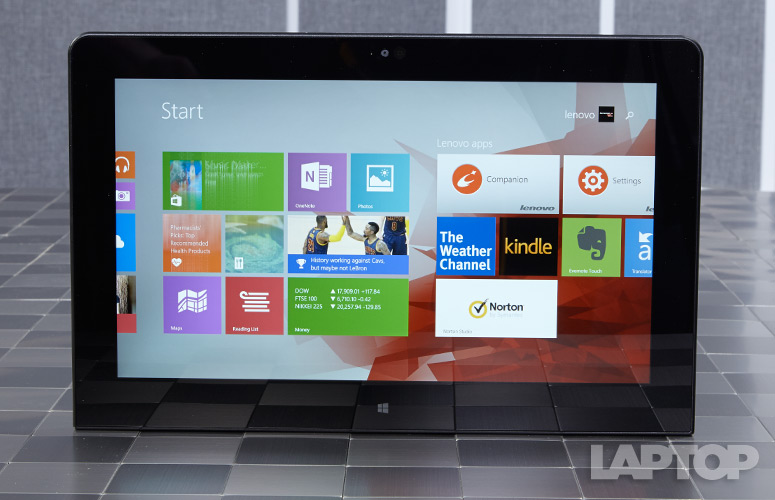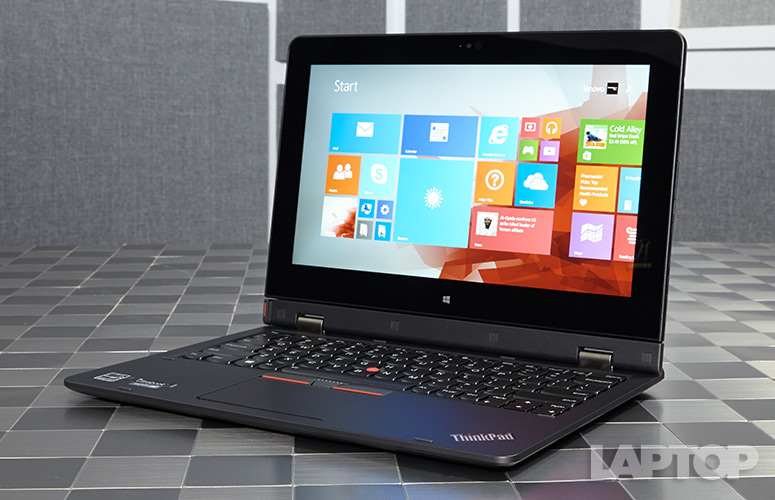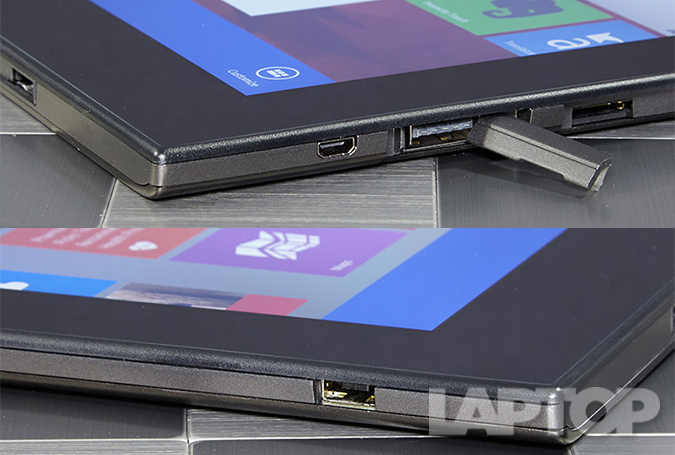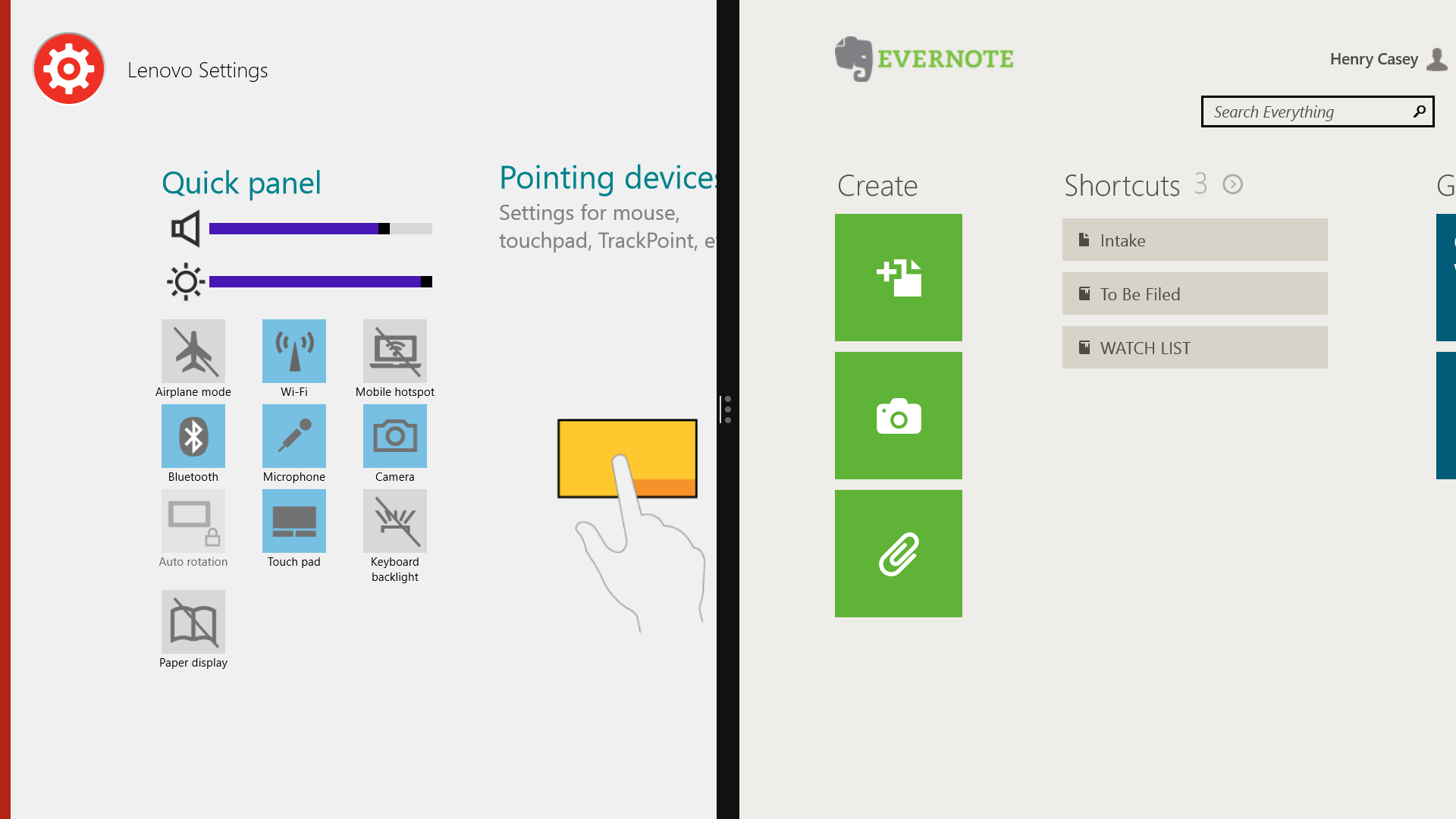Laptop Mag Verdict
The Lenovo ThinkPad Helix 2 is a great 11.6-inch tablet and laptop, offering a useful digital pen, top-notch keyboard and long battery life.
Pros
- +
Long battery life
- +
Design feels durable
- +
Excellent keyboard
- +
Bright display
- +
Great productivity application performance
Cons
- -
Heavier than competitors with keyboard attached
- -
Screen not very colorful
Why you can trust Laptop Mag
For business travelers, every pound carried and every inch of bag space matters. Hence, the increasing popularity of 2-in-1 devices, such as Lenovo's ThinkPad Helix 2. This 11-inch hybrid features a display that detaches from its keyboard, letting you use it as a tablet or laptop. With an Intel Core-M processor, 8GB of RAM and a 256GB SSD, the Helix 2 also has the kind of power that business users are looking for. Priced at $1,644 as configured (starting at $794), the Helix 2 is a premium hybrid, but its comfort, endurance and handy pen input make it a strong choice for mobile pros.
Design
The original Lenovo Thinkpad Helix was the first Windows 8 hybrid to use a detachable tablet design; the Helix 2 hews closely to its predecessor's look, complete with an all-black chassis, a great keyboard and the red TrackPoint.
The outer shell of the Helix 2 has a soft-touch matte finish that carries over to the keyboard's wrist rest and underside. At the upper right corner of the back of the tablet is a ThinkPad emblem with a red light over the "I" that serves as a system status indicator. In the upper left corner is a 5-megapixel camera, and below that is a fingerprint reader.
The front of the Helix 2 houses a 2-megapixel camera above the screen and a touch-sensitive Windows button on the bottom bezel. The Windows button gives a slight vibration whenever it's pressed, a nice way to confirm that it was activated.
On the top right edge of the tablet is a power button that is flush with the edge, as well as a lock button for enabling and disabling auto-rotation.
To detach the Helix 2's tablet from its keyboard dock, you push in the tab on the bottom left corner of the dock, and then lift the display up. Once it's been removed, the metallic flap that was positioned against the back of the docked Helix 2 now protects the docking port and two plastic connectors from damage. While strong and reliable, this setup isn't as elegant as the magnetic latch on the Toshiba Portege Z20; it simply detaches when you pull on the tablet.
Sign up to receive The Snapshot, a free special dispatch from Laptop Mag, in your inbox.
The Helix 2 is made in such a way so that the screen can face the keyboard, but also the other way around. This way, you can use the Helix in what Lenovo calls "Stand" mode (good for presentations), or just fold it flush with the keyboard for "Tablet+" mode. The + in Tablet+ stands for the keyboard dock's built-in battery, a feature also found in the Portege Z20t and the Venue 11 Pro.
MORE: Best 2-in-1s (Laptop/Tablet Hybrids)
Without its keyboard, the Helix 2 weighs a svelte 1.7 pounds, which is lighter than the original Helix (1.8 pounds) and the Surface Pro 3 (1.76 pounds), but heavier than the Dell Venue 11 Pro 7000 and the Portege Z20t (both are 1.6 pounds). Once you connect the keyboard, however, the Helix 2's weight increases to 3.65 pounds. That's lighter than the original Helix (3.8 pounds), but heavier than the Portege Z20t (3.2 pounds), the Surface Pro 3 (2.4 pounds) and the Venue 11 Pro (3.6 pounds).
Somewhat thinner than the original, the Helix 2's tablet measures 11.85 x 7.57 x 0.37 inches, and 11.85 x 8.39 x 0.79 inches when docked. The Helix 2 is also thinner than the Portege Z20t (12.2 x 8.5 x 0.83 inches), but thicker than the Type Cover-padded Surface Pro 3 (11.45 x 7.8 x 0.56 inches).
Display
The Helix 2's 11.6-inch, full-HD (1920 x 1080) IPS display offers bright visuals, but it could be more colorful. Watching a 1080p trailer for Metal Gear Solid V, the lens flares, floodlights and sunlit robotic arms all shined extremely bright, and the sandy roads had a lot of detail. A burning soldier glowed with vibrant oranges, and I could make out both the textured patterns of the flame-retardant armor and the pieces of rubble at his feet. Greens, though, as seen in soldier fatigues, seemed softer and less saturated than on other monitors.
At 306 nits, the Helix 2's display is brighter than the ultraportable average (277 nits), the Portege Z30t (288 nits) and the Surface Pro 3 (298 nits), but was outshone by the Venue 11 Pro (341 nits). The Helix 2's display also offered excellent viewing angles. I could see the action clearly even at 90-degree angles.
However, the Helix 2's display performed poorly in our color gamut test; it produced only 69 percent of the sRGB color gamut. That's better than the Portege Z20t (66.6), but well short of the category average (79 percent), the Surface Pro 3 (97 percent) and the Venue 11 Pro (101.7 percent).
Durability and Security
The Helix 2's shell is made of a mix of aluminum and ABS plastic, which has a very tough and secure feel to it. The keyboard deck and base are also made of ABS, while the strong, hard flap that protects the docking connectors is magnesium aluminide. Also, the Helix 2 has a durable, scratch-resistant Gorilla Glass 3 display, and can withstand drops of water.
MORE: The Best Laptops for Business and Productivity
Targeted at business customers, the Helix 2 has security features to warrant trusting it with sensitive company data. The fingerprint reader on the back of the tablet is tied to the Helix 2's Trusted Platform Module (TMP 1.2 compliant), which also stores encryption keys, passwords and certificates. Its placement is awkward, but keeping it there allows for use in both tablet and laptop modes. Also, the Core-M Y571 processor has vPro technology for management by IT departments.
Audio
The Helix 2 has two pairs of speakers -- one on the rear the tablet and the other on the undercarriage of the keyboard base -- and switches between each depending on whether the tablet is docked or not. In both positions the Helix 2 has enough audio power to fill a small room. Listening to Beyoncé's "Love on Top," the synths and bass on the low end of the spectrum were sturdy, and her vocals were juicy. However, the higher end sounded muddled.
Touch and Pen Input
With highly accurate touch sensors, the Helix 2 responded quickly to 10-finger gestures (such as pinch, zoom and swipe) during our testing. However, the high resolution display on the Helix 2 made small icons (anything in Chrome, for example) difficult to target in desktop mode.
I was impressed with the Helix 2's ability to capture my handwriting using the included Digitizer Pen. Testing it with the pre-installed Microsoft OneNote, the pen was highly accurate, and switching between drawing and selecting was very intuitive. The Helix 2 also did a great job at ignoring my palm resting on the display as I drew. I only wish there was a place to stow the stylus on the tablet.
Keyboard and Touchpad
Even though the Helix 2 is on the smaller end of the spectrum, its AccuType Keyboard offers exceptional feedback. On the 10FastFingers typing test, I reached an average typing speed of 64 words per minute with a 2 percent error rate. That's just below my average on a desktop keyboard (67 wpm). Its keys have 1.5 mm of travel and require 60 grams of force to actuate, both sweet spots for a good notebook keyboard. The Surface Pro 3's Type Cover offers a shallower 1mm of travel.
Typing on the Helix 2's keyboard in my lap didn't feel as comfortable as typing on a hard surface. Because the Helix is top-heavy, its display tipped backward whenever my wrists were not resting on the keyboard base.
Like the rest of its ThinkPad line, the Helix 2's keyboard has the familiar red TrackPoint between the G, H and B keys, a mouse alternative that continues to be highly accurate. Left-click, right-click and scroll buttons lie along the top of the touchpad.
Measuring 2.5 x 1.5-inches, the touchpad is not that large - it's 64 percent smaller than the touchpad on the original Helix - but it is still very functional. I found it easy to perform such multi-touch gestures as pinch-to-zoom and rotate, and the touchpad provided ample tactile feedback when clicked. The Helix 2 also supports Windows 8's touch-based gestures, such as swiping in to switch between apps.
Ports
The right edge of the tablet portion of the Helix 2 has a single USB 2.0 port, mini HDMI-out, an SD card reader and a headphone jack. The proprietary power connector is on the left edge of the tablet.
The keyboard includes a USB 3.0 port, a mini DisplayPort, a security lock slot and the Helix 2's second proprietary power connector, all along the back edge. I would have liked to see the keyboard dock contain an Ethernet port, a useful feature for business users.
Performance
Equipped with a 1.2-GHz Intel Core M-5Y71 processor, 8GB of RAM and a 256GB SSD, the Helix 2 offers more than enough performance for most business needs. The Helix 2 handled my daily rigors (a few dozen Chrome tabs, streaming audio or video, text editing, and the Evernote, Kindle and Weather Channel apps) without lag. Apps opened and closed quickly, even while Windows Defender was scanning all system files.
On the Geekbench 3 benchmark, which measures a system's overall performance, the Helix 2 scored 3,517, falling below the 4,567 ultraportable category average. The Helix 2's score was also below that of the Core i5-powered Surface Pro 3 (5,665), as well as the Core M-powered Portege Z20t (4,341) and the Venue 11 Pro (5,999).
The Helix 2's SSD duplicated 4.97GB of multimedia files at a rate of 188.5 MBps, which is faster than the category average (181.6), the Venue 11 Pro (130.5 MBps) and the Surface Pro 3 (145.5 MBps). It's only slower than the Portege Z30t (212 MBps).
The Helix 2 performed nearly as well on the LAPTOP OpenOffice Spreadsheet test, matching 20,000 names to their addresses in 5 minutes and 57 seconds. That's much faster than the category average (8:31), and just beats out the Portege Z20t (6:01). Still, the Venue 11 Pro (5:05) and the Surface Pro 3 (4:43) finished faster.
Graphics
With Intel HD Graphics 5300 integrated graphics, the Helix 2 is good for casual gaming, but not for anything more strenuous. On the 3DMark Ice Storm Unlimited benchmark, this hybrid scored 35,486. That's below the Venue 11 Pro (48,938) as well as the category average (39,146), but higher than the Portege Z20t (31,388) and the Surface Pro 3 (33,614).
The Helix 2's score on the 3DMark test didn't translate to a strong real-world gaming performance. While playing World of Warcraft with the graphics set to auto and the resolution at 1920 x 1080, the Helix 2 scraped out an unplayable 24 frames per second. That's slower than the Surface Pro 3 (36 fps), as well as the category average (also an unplayable 26.8 fps), but faster than the Portege Z20t (17 fps).
Battery Life
Like some other notebook-tablet hybrids, the Helix 2 includes batteries in both its tablet body and keyboard dock. On the Laptop Mag Battery Test (continuous Web browsing over Wi-Fi at 100 nits of brightness), the tablet's 35Wh lithium polymer battery and the keyboard dock's 26Wh lithium polymer battery combined to last for 10 hours. That's longer than the ultraportable notebook category average battery life (8:17), but well short of the times recorded by the Venue 11 Pro (13:33) and the Portege Z20t (14:37).
MORE: Laptops with the Longest Battery Life
The Helix 2's tablet portion lasted just 7 hours and 6 minutes. That's shorter than the tablet-only times of the Venue 11 Pro (8:00), the Portege Z20t (7:29) and the Surface Pro 3 (7:27).
Heat
After streaming a 15-minute Hulu video, the notebook's touchpad reached just 73 degrees Fahrenheit, while the G and H keys were 75 degrees. The hottest the Helix 2 got was on the back of the tablet, where it reached only 89 degrees. All of these temperatures are well below what we consider to be too warm (95 degrees), as well as the original Helix, which hit 102 degrees under the same conditions.
Cameras
The Helix 2 has a 2-megapixel front camera and a 5-megapixel rear shooter.
In a well-lit room, the front camera captured images that were very detailed, with accurate color. However, there was a persistent graininess that became more pronounced in darker conditions.
The rear camera produced clean photos with fine detail, though bright spots were far too bright, tap-to-focus was very slow to process and the autofocus was inconsistent at best.
A 1080p video shot using the back camera suffered from similar problems, with the camera seemingly unable to decide what to focus on. Overhead office lighting appeared as bright as a spotlight.
Software and Warranty
Lenovo Companion serves as a one-stop shop for all things Lenovo, including system health, warranty, productivity apps, games and accessories. Lenovo Settings provides quick access to change options for Mobile Hotspot, Power, Location Awareness, Camera and Audio, among others.
Password Manager 4 is included for organizing passwords, and securing them via the Helix 2's fingerprint reader.
Solution Center helps users back up their system, enable virus protection, perform system checkups and more. Lenovo PC Experience provides access to the Helix' system and hardware settings, user guide, system updates and more.
Other pre-installed third-party Windows 8 apps include Evernote, Kindle, Microsoft Translator and Weather Channel.
Our review model came with a three-year warranty, including one year for the battery, and 24-hour toll-free phone support.
Configurations
Our $1,644 review unit is the top-of-the-line Helix 2, sporting a 1.2 GHz Intel Core M5Y71-processor, 8GB of RAM, a 256GB SSD, the digital pen, the Ultrabook Pro keyboard and a 1080p display.
The entry-level Helix 2 costs $794, and has a 0.8-Ghz Intel Core M-5Y10c processor, 8GB of RAM, and a 128GB SSD.
The starting model also comes with the Ultrabook keyboard dock, which does not feature the secondary battery or TrackPoint, as found in in the Ultrabook Pro keyboard dock. However, it does have a slot for the stylus. If you're looking to upgrade, the Ultrabook Pro keyboard costs $320 (which is pretty pricey), versus $129 for the Ultrabook keyboard.
For $1,124, you can get an upgraded version of the entry-level Helix 2 with 4G connectivity, an NFC chip and the Ultrabook Pro keyboard.
Bottom Line
With its strong productivity performance, long battery life and useful digital pen, the Lenovo ThinkPad Helix 2 provides much of what business users need. This being Lenovo, the Helix 2 also has one of the best keyboards we've used in a tablet hybrid.
Dell's Venue 11 Pro 7000 has a more colorful display and even longer battery life, but it has a slower SSD and it runs hotter. We give a slight edge to the Toshiba Portege Z20t for its excellent endurance and easier-to-use magnetic latch, but the Helix 2 has a better keyboard. Overall, the Helix 2 should be a great addition to the bag of execs on the go who would like the added bonus of a tablet when they're travelling, but do not want to sacrifice the experience -- and keyboard -- of a traditional ThinkPad notebook.
Lenovo ThinkPad Helix 2 Specs
| Bluetooth | Bluetooth 4.0 |
| Brand | Lenovo |
| CPU | 1.2 GHz Intel Core M-5Y71 |
| Card Slots | 4-1 card reader |
| Display Size | 11.6 |
| Graphics Card | Intel HD 5300 |
| Hard Drive Size | 256GB SSD |
| Hard Drive Speed | n/a |
| Hard Drive Type | SSD Drive |
| Native Resolution | 1920x1080 |
| Operating System | Windows 8.1 Pro |
| Ports (excluding USB) | micro HDMI, Mini DisplayPort |
| RAM | 8GB |
| Size | 11.85" x 7.57" x 0.37" |
| USB Ports | 2 |
| Weight | 1.70 lbs. (tablet), 3.65 lbs. (tablet + dock) |
| Wi-Fi | 802.11 b/g/n/ac |
| Wi-Fi Model | Intel 7265 a/b/g/n |
Henry was a contributing writer at Laptop Mag. He penned hundreds of articles, including helpful how-tos for Windows, Mac, and Gmail. Henry has also written about some of the best Chromebooks, and he has reviewed many Apple devices, including various MacBook Air laptops. He is now a managing editor at our sister site Tom's Guide, covering streaming media, laptops, and all things Apple.









